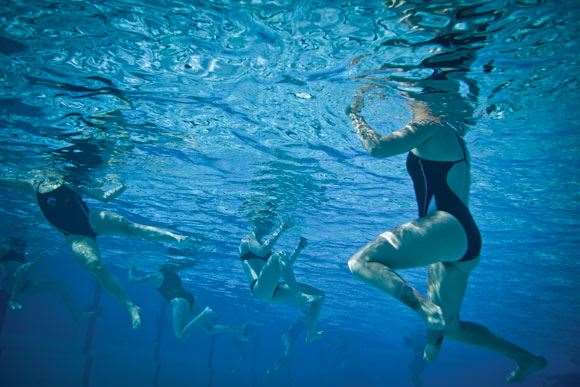Water polo is a sport made to measure for the Australian psyche: it’s rough, it’s tumble, and it’s played in water.
 Photos By, Shelby Hayden Craig
Photos By, Shelby Hayden CraigThe acid test
“We also do a lot of swim testing. A typical test is the 5x400m, where the finishing time goes down for every 400m block. These destroy us ... We also
do a swimming beep test. Basically, the intervals run at the same pace as the running beep test. We have to swim between two lane ropes 10m apart with the intervals between the beeps getting shorter and shorter the higher the stage. You just have to go and go until you miss the beep. It’s hard because there are lane ropes instead of walls, so you have to turn around in the water without pushing off. It sounds horrific, but it’s actually a lot easier than the 5x400s. We all prefer doing the beep test because, as soon as it gets too hard, you drop out, but with the 5x400s it’s just hard the whole time and you have to keep going.
“My best mark in the beep test is 12.3 – I think that’s the highest in our squad, actually. The aim for the centre forwards and centre backs is to get above level ten and the aim for the drivers is to get above level 11. Most of us are pretty good at reaching those goals.”
Weights for water
“In the gym, the focus is really the whole body. We do a lot of upper body work, with a focus on our lats for swimming and on our shoulders for shooting. We also do heaps of leg work; obviously our legs are working the whole game, trying to keep our heads above water. We do a lot of squats and power leg exercises like jump squats and lunges.
“As for sets and reps, it really depends on what training phase we’re in. In the pre-season we’re usually working on developing muscle strength, so we’re doing heavier weights – usually five sets of anywhere between four and ten reps. But going into a tournament, the focus is power, so that means higher reps, lower weight; more speed work with medicine balls and things like that. Within those phases the exercises themselves definitely change. Pre-season, we’ll do a lot of bench press, bench pulls, squats, chin ups. Going into a tournament, it’s more med ball work, more bodyweight exercises like push ups.”
By numbers
“With chin ups, my maximum is 12, which I think’s pretty good. For bench press, I can bench 82kg for one rep ‒ I only weigh 72kg, so I can do ten kilos above my body weight. With squats, my max is 85, and with bench pull my max is 75. But there are girls in our squad who push much bigger numbers than me – it really depends on the position you play as to what you’re better at. Centre forwards are normally bigger girls, so they’re not so good at body weight exercises, but they’re really good at squats, because they’re always using their legs to push around the defence, hold their position in the water. One of the centre forwards in our squad can leg press 320kg! Goalies tend to focus more on power and reflex exercises, so they also tend to be good at the leg work because they do a lot of plyometric exercises, a lot of box jumps in their program. And the drivers are typically the ones who are good at the bodyweight exercises because they tend to be a bit slimmer. One of the drivers in our squad can actually do 23 chin ups. Her name’s Jane Moran; she’s one of the shorter girls in our group but she’s a gun in the gym.
“Look at a team of 13 water polo girls and there’s always a massive variety of body shapes and sizes. Some girls are tall and slender; you take one look at them and know they’re an athlete. But some of the best players in the world don’t even look like athletes! Take Brenda Villa from the USA, for example. She’d be five foot six and she’s this tubby little thing ‒ but she’s such an amazing player. It really depends on your own style of play. Some girls are really big and they use their bulk to hold their position in the water. Other girls are slimmer and rely on their pace and agility.”
‒ Aaron Scott
Related Articles

Bronzed finish for Stingers at World Championships













